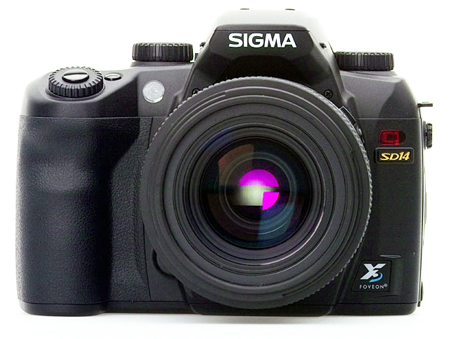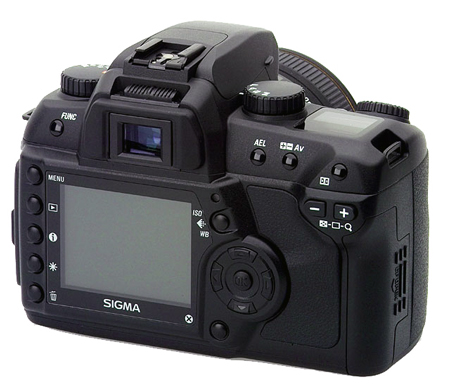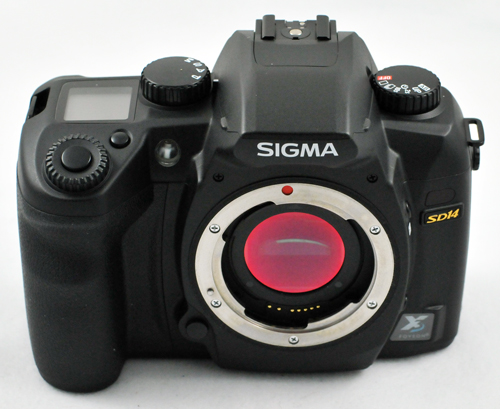Sigma SD14: Quick Look at a Quirky Wonder
by Wesley Fink on June 3, 2008 4:20 AM EST- Posted in
- Digital Camera
Evolution of the SD14
It
is impossible to talk about the specifications, controls, and features of the SD14
without comparing it to the cameras that came before it - the Sigma SD9 and SD10.
Sigma has really refined the SD14. The area that stands out most in the new design is the viewfinder.
The SD9 and SD10 used the old Sigma 35mm viewfinder with dotted lines to show the
new view of the 1.7x sensor. It was almost laughable that their marketing referred to this as some
special form of sports finder where you could see what was outside the frame and
moving into it. The SD9 and SD10 were so slow no one would ever
even consider using them for action photography, so it was all too clear that Sigma
was just recycling an existing 35mm viewfinder.

Interestingly enough the SD14 viewfinder is quite decent. It is a pentaprism (not a pentamirror) and reasonably bright, with 98% horizontal and vertical coverage. This is better coverage than the 95% of the 40D for example, but the Canon 40D has a better .95x magnification compared to the .9x of the SD14. However, compared to the earlier SD10 magnification of .77x the new SD14 viewfinder is dramatically improved. Sigma also claims the viewfinder is high eyepoint, which makes it easier for eyeglass wearers to use. The eyepoint spec is 18mm, which is the same as the Nikon D3.

This is also the first Sigma SD with five AF points. The earlier SD9 and SD10 had a single-point AF module that looks about the same as the 15-year old SA300N. The five focus points are spread widely across the frame, which significantly increases the AF frame coverage on the SD14.

There is also an easy-to-adjust diopter correction on the top of the viewfinder, a real depth-of-field preview button on the left side of the lens mount, and the first built-in pop-up flash in the Sigma SD series. These are nothing special at the original selling price of $1699, but with Cameta and Amazon recently selling the SD14 body for less than $600 they are really standout features at the new price point.
There are also updates that are not so obvious in the SD14, such as USB 2.0 instead of 1.1 and a dramatically improved shutter with a rated life of 100,000 actuations. The new shutter tops out at 1/4000 instead of 1/6000 like the SD10, but a year in the field is proving the new shutter doesn't disintegrate and shred small pieces in the sensor chamber. This was a complaint some had with the SD10. The new shutter is also very quiet - much quieter than the earlier models - and frankly one of the quietest shutters we have found in any camera in its class. That is a welcomed improvement.
This is also the first Sigma SD to use a rechargeable Lithium battery. The earlier models used AA batteries or the CR-V3 variant. Thankfully the new battery is an easy-to-find and reasonably priced NP-400, a battery that is also used in the Minolta 7D/5D, and the Pentax K20D/K200D/K10D. Pentax calls their battery the D-Li-50, Sigma calls it the BP-21, and Minolta called the battery the NP400. Whatever they call it, all three batteries are interchangeable, which makes it easy to find reasonably priced replacement batteries.
Our early experience with battery life was extremely poor. This also appears to be related to the early CF compatibility issues we experienced. After charging to a different brand of CF card that worked better on the SD14 we fired off about 300 shots before depleting the battery. Battery life is better than we first thought, but it is not in the same league with Canon and Nikon CMOS sensors. It is probably a good idea to carry a spare battery or two if you plan a lot of shooting. Note that some users claim battery life does improve after the battery is "conditioned" in the Sigma charger.

As seen on previous SD cameras, Sigma mounts a sensor protector just behind the lens mount to keep dust away from the sensor. The reddish-pink filter inside the lens mount is also the Infrared filter. This makes the SD14 uniquely suited for digital IR photography since the filter is easy to remove without any special tools. The SD14 without this filter is sensitive to both IR and visible light, and by using an IR filter you can make the SD14 sensitive to IR only. The word among IR enthusiasts is that there is nothing better on the market for IR photography than the SD14, and that option is there if you choose.

Sigma uses the Sigma SD all-electronic lens mount, and can only natively mount Sigma lenses. Many photographers do not realize the Sigma mount is all-electronic like the Canon mount, and it has been in existence for more than 15 years. Here you see a very new 18-200mm OS (Optical Stabilized) Sigma lens mount beside a 15+ year old Sigma 50mm Macro lens. The 50mm Macro works perfectly on the new SD14. In fact, the Macro was used for most of the sample images at the end of this review.
Lenses for the SD14 are only available from Sigma, but the current Sigma lens catalog shows 39 lenses available in Sigma SD mount, and there are additional lenses that were made in Sigma mount that have been discontinued over the years. The lens multiplier is 1.7x, just slightly more than the Canon 1.6x, which means the equivalent 35mm focal length is the focal length times 1.7x. That means a 50mm normal lens behaves like an 85mm portrait lens on the SD14.
It is a little more work to find Sigma mount lenses for sale, but Amazon, Cameta, and B&H usually have a decent variety. Sigma also makes their most interesting new lenses, such as the new 18-200mm f3.5-6.3 OS available in Sigma mount. That lens on the Sigma, as with the Nikon 18-200mm VR, is quite a match. It provides a 35mm equivalent of 31-340mm in a single lens with up to four stops of added speed thanks to the new Sigma dual-motor OS.
You can also find Sigma-mount lenses for sale on eBay, sometimes at bargain prices. The Sigma-mount 35mm lenses will fit the new SD14 and they are often very cheap if you are trying to build a quality system on a shoestring.










40 Comments
View All Comments
justascot - Wednesday, June 4, 2008 - link
Pinto if you are genuinely looking for an extra tool to complement the 5d that you already own then you may well be interested to read a comparison between the 5D and the SD14 as carried out by another user as found here http://www.ddisoftware.com/sd14-5d/">http://www.ddisoftware.com/sd14-5d/Personally I find Image quality to be a subjective thing. I own the SD14 myself and enjoy it but I would never try and suggest that it is always going to be a better camera than your 5D. Your 5D is capable of working in different areas than the SD14 but you may well find on occasions (if you like the IQ of the foveon look that is) that you will prefer to use the SD14 for certain subject matters but that depends on 3 factors - your shooting style, your photographic interests and your ability to see the difference between the foveon and the bayer image and most importantly that like what you see.
I'm not going to try and sell you a SD14 that should be Sigma's job, I just see the camera (whoever manufacturers it) as a tool in which to do a job. I happen to like the end result of what this tool is capable of in the areas that I have in interest in - that being landscapes, portraiture and IR. Having used this camera for a few months now and seen the images of other users I am also gaining more of an interest in macro. These are all areas in which the SD14 excels if you have an interest in any of those fields it might well be worthy of further consideration by yourself.
As for the Megapixels argument, I have little time for that between any manufacturer. The quality of the megapixels seems to vary greatly between camera and camera no matter whether a foveon or bayer chip is used. I know from experience that there is a lot of information in a raw foveon image that suggests it is greater than the 4.7MP that some say, but less than the 14MP that Sigma would like us to believe. There are some users that say they can get print up to A0 with a SD14 file, and Sigma have been known to do this themselves but personally I've never felt the need to print that extreme. A2, or perhaps on the rare occasion A1 would be perfectly adequate for my needs and for that the raw file of the SD14 is ideal. It takes a little bit of skill to get the most of the foveon file. In my experience I found the auto white balance wasn't good enough for my needs but after switching to custom white balance in camera I found the results improved dramatically.
My advise is to do your research and look at what others who own the SD14 are able to get out of it and decide from there. In the end that's what sold it for me. The cheap price although a factor in sparking my initial interest was also something that put me off to an extent but it was the photography of the long term users that persuaded me in the end not the marketing by Sigma or megapixels argument between bayer or foveon fans.
pinto4402 - Wednesday, June 4, 2008 - link
Your comments are well taken. Thank you for taking the time discuss this with me.justascot - Wednesday, June 4, 2008 - link
You are welcome. I hope whatever conclusion you come to, it proves to be the right decision for you.My apologies for my lack of spacing between paragraphs in my previous comment I hadn't realised my mistake until after I pressed send.
Wesley Fink - Tuesday, June 3, 2008 - link
WE WERE WRONG ABOUT START-UP.We used three different 8GB CF cards in the course of testing fro this review. All were 280X cards based on Samsung memory chips, and all 3 cards have worked fine with every other camera we have tested at AT.
After receiving several emails from SD14 users reporting startups of 1 second or so we tried two new CF cards of different brands - a 16GB and a 4GB. BOTH the new cards initialized in about a second and we have not experienced a lock-up yet in shooting with either card. THE STARTUP DELAY AND LOCK-UPS APPEAR TO BE THE FAULT OF CF CARD COMPATIBILITY ISSUES AND NOT THE SD!$ CAMERA.
We will revise the review shortly to reflect these findings and also update the lock-up issue as soon as we have had more time with the new cards.
justascot - Tuesday, June 3, 2008 - link
By on large as a Sigma SD14 owner of a few months I found this a fair and reasonable review, except on one matter. The experienced start up time of the author of this review puzzles me greatly. When I turn on my camera, within about a second its ready to go. If I had experienced an 8 second start up time I would have returned it to the shop in frustration. Sadly I'm not patient enough to deal with a start up time of that magnitude, thankfully I've not had to do just that. In fact the start up time has never been an issue for me. I'm not sure why the author experienced this issue, perhaps it was the 15 year old lens that was used although that seems unlikely.There are areas where the camera is slow, writing to card for instance - so for someone who is used to a quicker camera it does mean an adjustment in shooting styles.
Anyway about from the issue I highlighted it was a fair review. The Image quality of the camera is superb with good quality lens when combined with good skills of an experienced photographer. I would say the IQ compares favourably with the mid priced dslrs albeit at low isos, and with the current price of the SD14 it is a bargain, especially when you consider you have two cameras for the price of one if you are into IR. Most if not all other Dslrs require a permanent irreversible modification if you want to shoot in IR, whereas with the SD14 you can easily swap between regular colour and IR as your mood dictates.
I would never try to suggest this as a camera for everyone, its a specialist camera but if you have an interest in Landscape, Macro, portraiture and/or Infrared photography its well worth consideration for the image quality capabilities of the camera and the price - and unless something is very wrong it should be ready to shoot without contemplating whistling the first few notes of "Why are we waiting...."
Souka - Tuesday, June 3, 2008 - link
9 sec start up time? Probably running a flavor of Windows....crimson117 - Tuesday, June 3, 2008 - link
This is hardly primitive gear. As Wesley wrote in the review, since no other major manufacturer has used the Foveon sensor, it's impossible to know whether it's the camera design or just the sensor itself that is responsible for the slow response times.Your portrait photographer friends don't need a really quick camera, as portraits are usually carefully set up and controlled. Add in unbeatable image quality and it sounds like the right choice for a portrait photographer.
aeternitas - Tuesday, June 3, 2008 - link
Layer-per-primary is the future of digital photography. I can't wait till Canon or Nikon do the same, as they are bound to wrap more accurate hardware around the technology.For more pictures
http://reviews.photographyreview.com/blog/sigma-sd...">http://reviews.photographyreview.com/blog/sigma-sd...
s12033722 - Wednesday, June 4, 2008 - link
Layer-per-primary is definitely NOT the future of digital photography. It's a concept that sounds nice, but in practical application things are a lot muddier. The basic problem is that while the literature makes it sound like red photons go to one layer, green to another layer, etc, the reality is that you don't get nice discretely separated layers. Photons of a certain wavelength will generally penetrate silicon to a certain depth, but that depth varies based on a lot of factors, and photons come in a continous spectrum, not discretely separated wavelengths, so the reality is that you get a nice soup of photons all being absorbed in the "red" layer that may not be red at all. The sigma cameras are only able to produce their images through some very impressive image processing.If you want R, G, and B information at each pixel, there is a good way to do it: 3-CCD technology. Use a beamsplitter to image the same scene with 3 different imagers each filtered for one color. That will give you correct tri-color information at each pixel, but it costs a lot and it can be quite difficult to design.
Justin Case - Friday, June 6, 2008 - link
And has no real advantage over a single Bayer sensor with twice the height and width. Takes up (a lot) more space, cost more and is extremely hard to align (different wavelengths diffract differently).